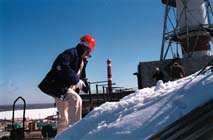| Previous: The Challenge of Chornobyl | Next: Operational Safety Improvements |
 A technician uses a portable
survey instrument to measure radiation levels on the shelter roof.
A technician uses a portable
survey instrument to measure radiation levels on the shelter roof.
|
Shelter Renovation and Worker Safety Improvement
Ukraine, the G-7 countries, and the European Commission have agreed on a plan to stabilize the shelter over the ruined Unit 4 reactor building, build a new protective structure, and remove portions of the existing shelter to ensure its long-term stability. The United States' participation primarily involves cooperative activities to develop designs to correct the shelter's structural problems and to improve worker safety in the shelter. Stabilization of the existing shelter and construction of a new shelter are expected to be completed by 2005, five years after the remaining operational reactor, Unit 3, was shut down.As cleanup work and renovation activities at the shelter increase, so will worker exposure to radiation and other safety hazards. Ukraine lacks the financial resources to provide the basic equipment and training required for worker safety at the shelter. The United States is working with the world community to provide Ukraine with the necessary equipment and training. Initial efforts are concentrated in six areas: shelter structural integrity, radiation dose reduction, nuclear (criticality) safety monitoring, dust suppression, industrial safety enhancement, and emergency preparedness.
Chornobyl's Unit 3, which remained operational until December 2000, and the ruined Unit 4 reactor building (the shelter) share a ventilation stack mounted on a common auxiliary building. The 1986 accident heavily damaged the bracing that secures the stack to the auxiliary building, making the stack vulnerable to collapse. International experts have identified stabilization of the stack as a "necessary and urgent" short-term measure to reduce the risk to workers. Because of the urgency, the Chornobyl Shelter Organization developed a plan for stack stabilization and committed to performing the work during the summer of 1997. The initial plan projects a completion time of 4200 man-hours and worker exposure of 4600 man-rem. At the request of the Shelter Organization, a U.S. team reviewed the repair plan and helped identify an alternative approach that reduced worker exposure to 400 man-rem and the completion time to 1700 man-hours. In response, Chornobyl management made the review a standard for all future high exposure jobs at the shelter.
The U.S. Department of Energy has purchased a variety of equipment to
improve worker safety at the shelter. To reduce the radiation dose to
workers, dosimetry equipment, dose-tracking software, portable survey
instruments, radiation protection clothing, and respirators are being
provided. Radiation protection technicians also are receiving expert
mentoring and standards-based training. Nuclear criticality monitoring
will be improved by installing modern neutron detection equipment inside
the shelter. Three portable, airless sprayers will be provided to reduce
radioactive dust in access areas and other high traffic areas for
personnel. The United States and Ukraine also seek to improve worker
safety by developing a telerobotic unit for remote visual evaluation and
monitoring of areas inside the shelter that are too radioactive for
routine human access.
![]()
| Previous: The Challenge of Chornobyl | Next: Operational Safety Improvements |
 A cleanup worker wears U.S. -supplied
radiological protection equipment required to work safely in the
shelter.
A cleanup worker wears U.S. -supplied
radiological protection equipment required to work safely in the
shelter.  The 20-story,
300,000-ton concrete shelter was constructed hastily to contain some 190
tons of irradiated fuel. The ventilation stack is shown on the
left.
The 20-story,
300,000-ton concrete shelter was constructed hastily to contain some 190
tons of irradiated fuel. The ventilation stack is shown on the
left.